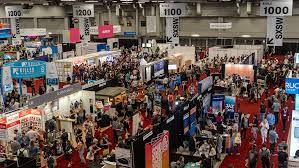Developing your trade show marketing plan is key to ensuring that your brand message is heard. You should do extensive research about your target audience and design event marketing materials that speak directly to them. Trade shows are highly collaborative, involving a number of moving parts. Make sure that you and your team have all the resources necessary to get your message out to the right audience. Here are some tips to ensure that your team has the skills and tools necessary for success at your next event.
Attending trade shows is a great way to connect with customers, strengthen relationships with distributors and dealers, and network with influencers. Attendees attend trade shows to learn about the latest innovations, network with colleagues and influencers, and get a firsthand look at the industry. Although you’re not paying for booth space, you’ll be spending less money than an exhibitor. Some smaller companies choose to network with captive exhibitors, and this is a good strategy if you’re looking to get your name out there.
A successful trade show marketing campaign is a well-planned strategy that incorporates several steps. To ensure that the campaign works, you should analyze the floorplan, floor plan, and past show data. These steps will help you identify any gaps in your plan and ensure your brand is well-presented. Using a cost-benefit analysis to plan your trade show marketing campaign will help you understand which components of the show are worth spending time and money on.
Before choosing a trade show, you should understand its audience. What types of people are likely to attend? Is it primarily decision makers or other high-level executives? Are the attendees of your target audience the people who will buy your products? Do you plan on spending time at large conferences? There’s always a chance that you’ll come across a person who is a decision maker, and if you’re not there, it will reflect poorly on your company.
The goal of your trade show participation should be clearly defined. Determine whether your exhibit has two primary targets: selling goals and image. Your effectiveness measure should reflect which one you’re pursuing. If you’re looking for the lowest cost way to learn more about your competitors, you might consider attending trade shows in person. You’ll gain an insight into your competition. You’ll learn more about your competition and their products. In addition to getting a wealth of information about your competition, trade shows can also be a great venue for product testing.
Changing the face of trade shows has helped companies create new strategies for reaching their customers. Instead of the crowded booths, desperate salesmen, and cheap promotional efforts of the past, trade shows now offer unmatched showcase spectacles. Companies invest time and money in creating creative productions and presentations to wow their audience. Some major trade shows feature music performances from famous musicians, cutting-edge multimedia exhibits by large companies, and keynote speeches by influential technology influencers. All of these elements make trade shows more like a movie premiere – and they have the potential to excite a crowd.

